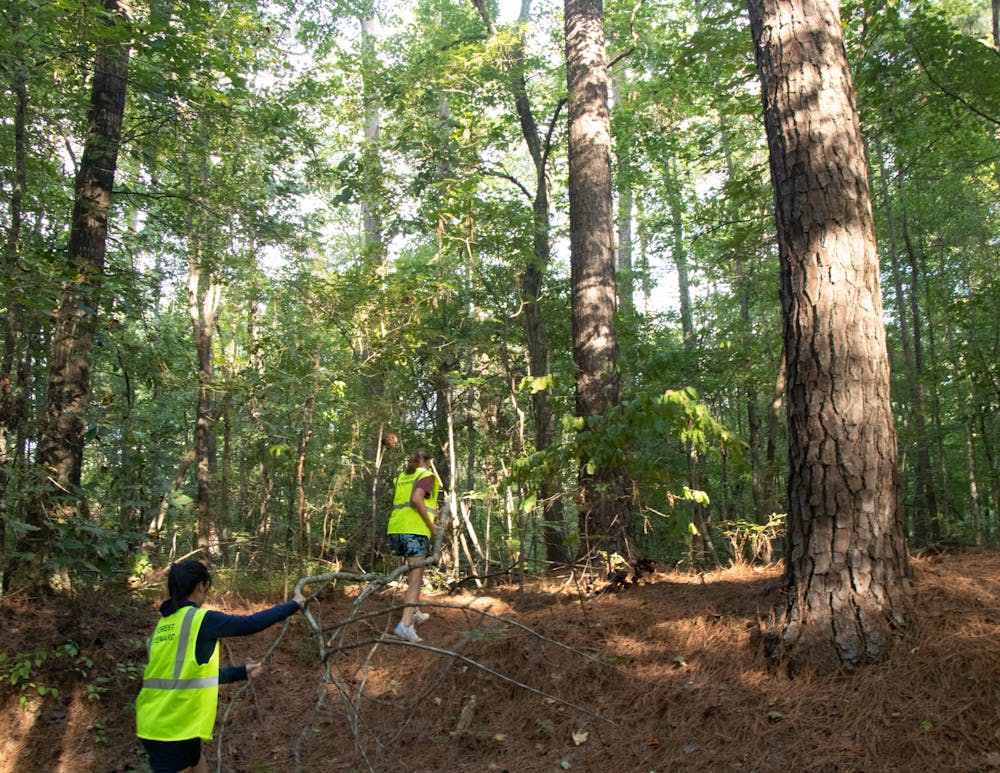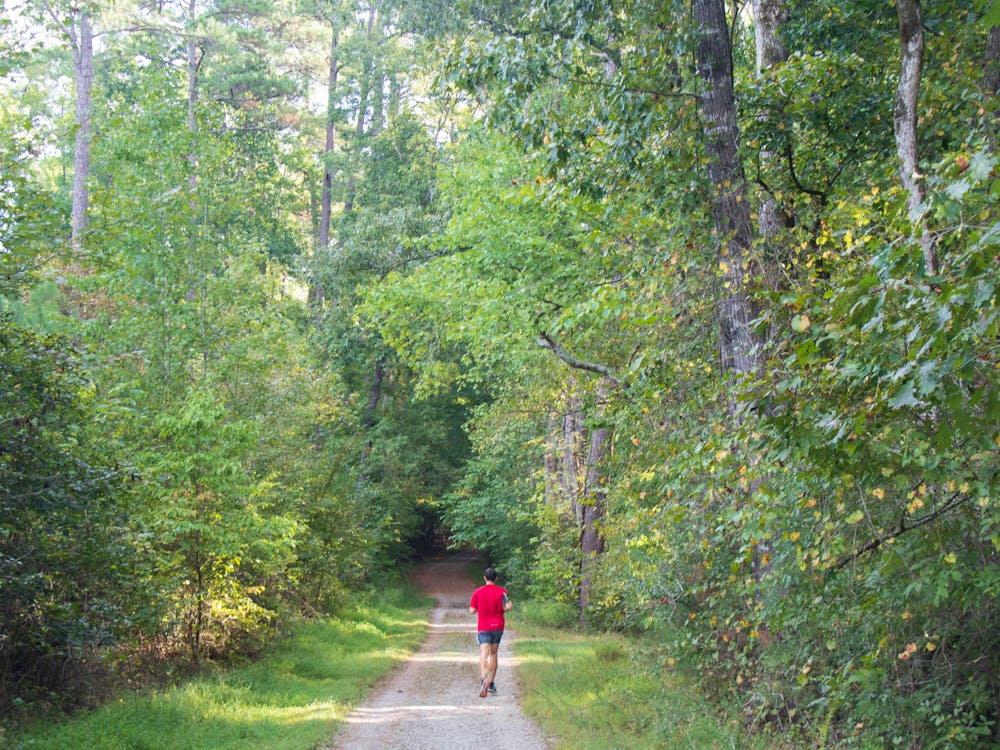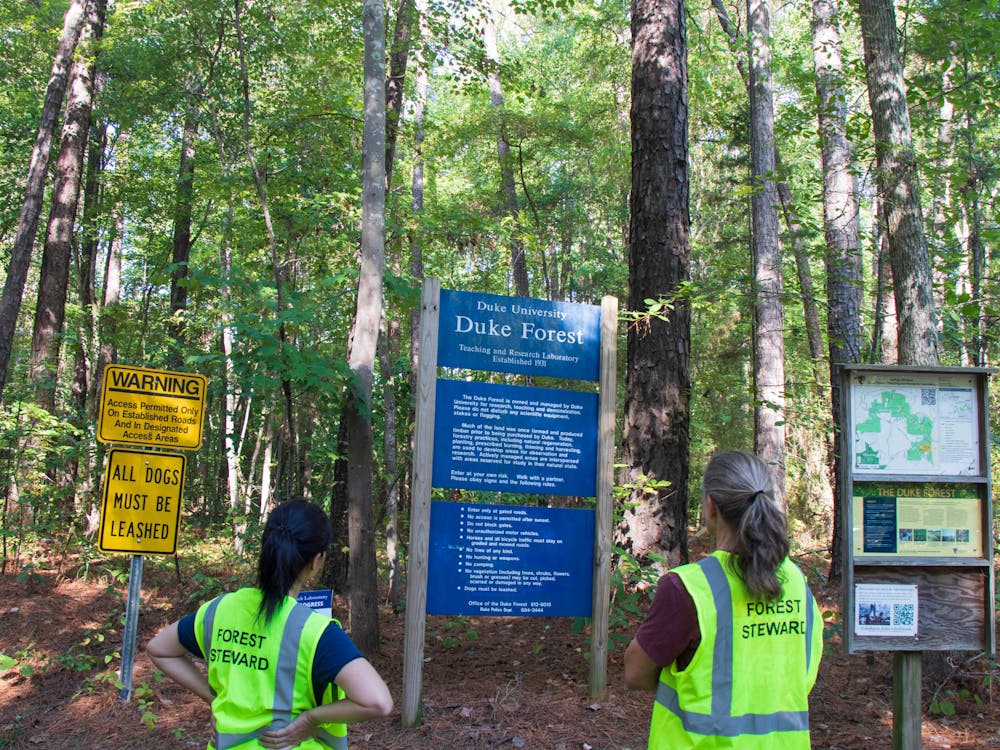On a warm Sunday morning, made cooler by the shade of the towering pines, Ann Leininger and Kim Satterfield worked together to move a large branch out of a ditch in the Durham Division of the Duke Forest.
The pair donned bright yellow volunteer vests reading “Forest Steward” as they cleared up debris. Their work that morning, Leininger explained, would help prevent the creation of a dam during heavy downpours.
Leininger and Satterfield are part of the inaugural cohort of the Forest Stewards Volunteer Program to help keep recreation sustainable in the University’s private research forest. Launched in July, the program selected 14 pairs of volunteers to walk trails in Duke Forest twice a month to remove fallen branches, tally the number of visitors and provide valuable information on trail traffic and conditions to the Office of the Duke Forest.
Maggie Heraty, program coordinator for Duke Forest and the manager of the program, said the use of the word “steward” was intentional.
“In order to keep that place healthy and have it as that resource, we need people to help protect it and really recreate in a way that is responsible and positive, but not causing undue burden on the ecosystem that [they are] walking through,” she said.

Loving nature to death
Heraty cited the COVID-19 pandemic as a driving factor for the creation of the program, when the Duke Forest had a huge spike in recreational visitation.
In August 2020, Duke Forest staff released a Recreational Impact Statement, which documented “a dramatic increase in unauthorized recreational activities and associated negative impacts” during the pandemic. Issues ranged from unauthorized trails to physical structures to damaged research sites.
According to Heraty, this phenomenon was not specific to the Duke Forest.
“A lot of these natural areas that people actively steward and manage are sort of facing this thing that a lot of people are calling ‘loving nature to death,’” she said.
Enter the Forest Stewards, who provide “critical capacity” to the small staff at the Office of the Duke Forest” and “steward the well-being of the Forest into the future.”
Heraty, who led the selection process, noted that many Stewards are already familiar with the Forest.
“We have some folks who have lived in this area around Durham or next to the forest for many years, who love the forest and want to be involved in protecting and stewarding it,” Heraty said. “We even have some parent and child teams, which I find really lovely.”
This is true for Leininger and Satterfield, who have been visiting Duke Forest for years and would meet to catch up about their kids.
“When the pandemic hit, we were both so grateful to have the opportunity to be outside in a way that was safe, and still connect with each other,” Leininger said.
As Leininger and Satterfield walk along the gravel path, they spotted a tepee constructed out of wooden poles on the forest’s edge. They decided to file a report, so Satterfield snapped a picture and used Google Maps to record the exact longitude and latitude of the issue.
“I think that's a really cool thing — to use this technology to identify issues in the forests,” she said.
To date, 28 Forest Stewards have completed 76 visits to the Forest. Each prospective volunteer applied and was selected from a pool of 85 applications this past June, Heraty said.
Of the Duke Forest’s six divisions, the Durham, Korstian and Edeburn receive the most recreational use and have the highest concentration of trails. The Stewards are currently stationed at these three divisions, according to Heraty.

Looking forward
For Heraty, the future of the Forest Stewards looks bright. After this year, which Heraty considers to be a “pilot” year, leaders plan to reflect on their successes and areas of improvement. The goal is to make this program run annually.
“The best way for people to hear updates or even learn more about the Forest, while they’re waiting to actually get involved in this program, is to sign up for our newsletter,” Heraty said. Prospective volunteers can subscribe to the newsletter on the Duke Forest website.
“I would encourage anybody in the area to come and take advantage of these trails because they are beautiful. And it's such a great mental health break. And a great way to spend time with friends,” Leininger said.
Correction: A previous version of this article incorrectly stated that the Duke Forest has seven divisions. It has been updated to state that the Duke Forest has six divisions. The Chronicle regrets the error.
Get The Chronicle straight to your inbox
Signup for our weekly newsletter. Cancel at any time.

Senou Kounouho is a Pratt sophomore and a university news editor of The Chronicle's 119th volume.

